› Forums › Spectroscopy › ALHENA WITH A STARANALYSER
- This topic has 12 replies, 4 voices, and was last updated 8 years, 1 month ago by
 Peter Taylor.
Peter Taylor.
-
AuthorPosts
-
25 October 2017 at 9:59 am #573872
 Peter TaylorParticipant
Peter TaylorParticipant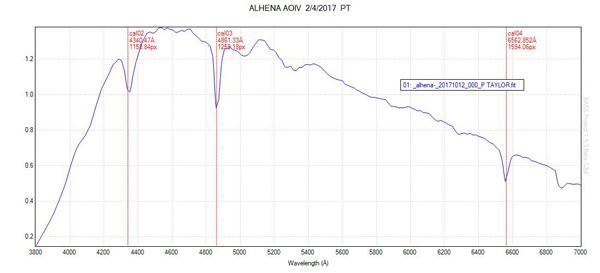
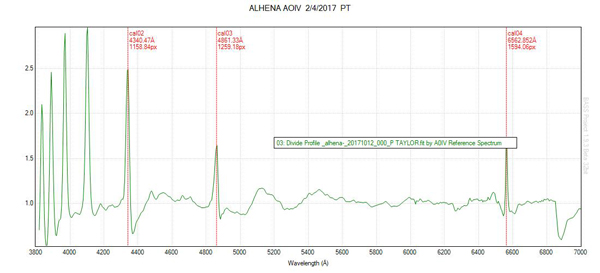
 Hi All After a lot of trial with ISIS and BASS I retried to do ALHENA image I had is this about right.
Hi All After a lot of trial with ISIS and BASS I retried to do ALHENA image I had is this about right. peter
Attachments:
26 October 2017 at 8:49 am #578670 Andy WilsonKeymaster
Andy WilsonKeymasterHi Peter,
Nice you are starting to get results. You can pick out the strong hydrogen absorption lines of this A-type star, from right to left H-alpha, H-beta and H-gamma are clearly visible with a hint of H-delta at about 4100 Angstroms. You also have an atmospheric telluric band just short of 6900 Angstroms.
Best wishes,
Andy
26 October 2017 at 2:27 pm #578671 Robin LeadbeaterParticipant
Robin LeadbeaterParticipantHi Peter,
You are definitely making progress and are almost there with this result. The wavelength calibration is good and the instrument response is approximately right but there are a couple of improvements you can still make.
If you compare your final response corrected spectrum (blue in the last graph) with the library spectrum (purple),there are some humps in your spectrum between 500-5400A which do not appear in the library spectrum. The continuum at the short wavelength end agrees well but at the long wavelength end, your spectrum drops below the library spectrum.
Can you post your uncorrected and corrected spectra fits files (blue in the top and bottom graph) as attachments (change the extension from .fit to .fits so the forum accepts them). and I will have a closer look at where the problem might be.
Cheers
Robin
26 October 2017 at 6:54 pm #578673 Peter TaylorParticipant
Peter TaylorParticipantHi Robin, I loaded my 20 images in to ISIS but no flats darks or bias haven’t got to them number 1 is the first and 2 is the last 9 is out of CCD hope theas are OK, thanks very much for your help. peter
27 October 2017 at 6:10 pm #578675 Robin LeadbeaterParticipant
Robin LeadbeaterParticipantHi Peter,
The spectrum profiles you attached have a problem with the wavelength calibration which the graphs you posted do not so I went back to your spectrum image and recalibrated that in wavelength first. I then calculated the instrument response and applied it to the raw spectrum to produce a final instrument response corrected spectrum. You can see below the raw spectrum (blue), the instrument response (orange) and the final result (green).
As a check I also compared the final result (green) with the reference spectrum (pink) which I filtered to match the resolution of the measured spectrum. You can see the good agreement in the shape of the continuum which confirms the instrument response is working correctly.
I have attached the steps I took to produce the final spectrum in the attached pdf. I used Vspec as it is easier to see the individual steps but you can use any software package to produce the same result.
I hope you can follow this ok
Robin
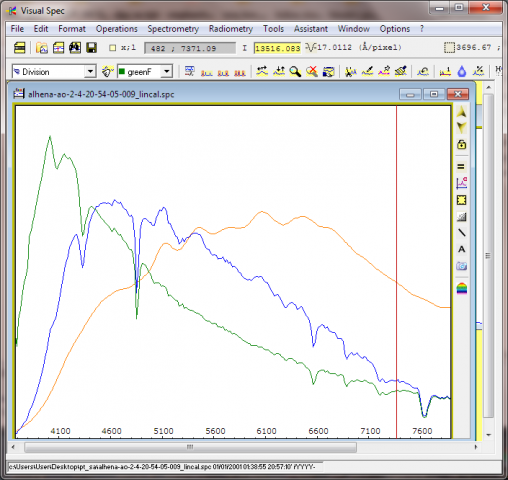
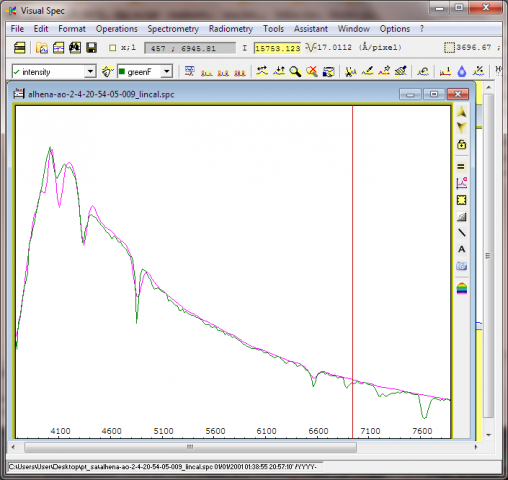 27 October 2017 at 6:36 pm #578676
27 October 2017 at 6:36 pm #578676 Hugh AllenParticipant
Hugh AllenParticipantHi Peter,
I also captured the spectrum of Alhena with a Star Analyser (SA200 in my case). My result is attached and is in pretty good agreement with your own. I wonder if you should also have a play with the focus to see if you could capture one or two more of the Balmer lines at shorter wavelength? I use an Atik 314L camera and I process the images in BASS. I like the BASS alignment function for stacking the images, it seems to do a good job on aligning the Star Analyser images when the star can shift slightly in position from one image to another. Anyway I think your results are looking very promising
Cheers
Hugh
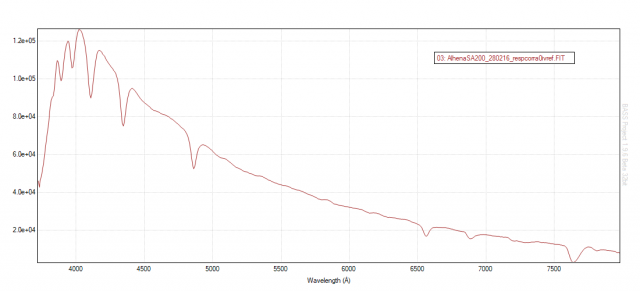 27 October 2017 at 6:56 pm #578677
27 October 2017 at 6:56 pm #578677 Hugh AllenParticipant
Hugh AllenParticipantHi Robin,
Could you explain a bit more about the process of filtering the reference spectrum so that the resolution more closely matches the measured spectrum?
Cheers
Hugh
27 October 2017 at 8:51 pm #578678 Robin LeadbeaterParticipant
Robin LeadbeaterParticipantHi Hugh,
If there is a big disparity between the resolution of the measured and ref spectra I find it is useful to apply a (typically spline) filter one of them to match the resolution before doing the division as that (along with slightly wavelength shifting them as necessary) makes editing any remaining artifacts out of raw instrument response easier. It did not work perfectly in Peter’s case as typically the Star Analyser resolution varies along the spectrum but attached is an example of the division with and without filtering with my very low resolution ALPY 200 and the MILES reference spectrum. It is also useful in high resolution spectra using the LHIRES where the line profile of a ref star like Vega for example can take up most of the width of the spectrum. Here I did the smoothing manually in VSpec but the response function in ISIS has both filtering and offset adjustment capability built in to the response function calculator.
Cheers
Robin
28 October 2017 at 11:24 am #578679 Hugh AllenParticipant
Hugh AllenParticipantHi again Peter,
Once you feel you’ve mastered the processing of your spectra following Robin’s guidance, there is a nice little project you could try. In the same area of sky as Alhena there is a bright 4th magnitude Be star called nu Gem (Hα line in emission instead of absorption). Overlaying the spectra of Alhena and nu Gem clearly shows the difference in the Hα line between the two stars….
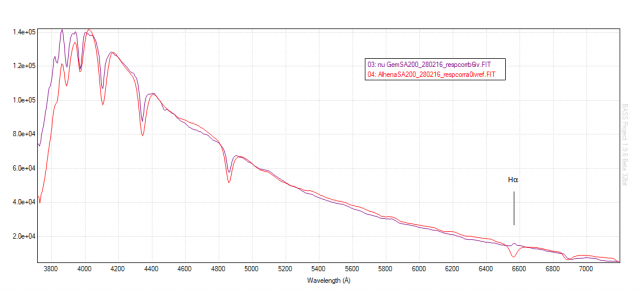 28 October 2017 at 1:19 pm #578680
28 October 2017 at 1:19 pm #578680 Hugh AllenParticipant
Hugh AllenParticipantThanks Robin, that;s very interesting and not something I had thought about before. I can see in BASS the filtering option under the ‘Resample Profile’ tab which offers a couple of options, ‘low pass’ and ‘low pass Gaussian’. The Gaussian option looks to deliver the better filtered profile in comparison to my Star Analyser spectra.
Much appreciated
Hugh
28 October 2017 at 3:04 pm #578681 Robin LeadbeaterParticipant
Robin LeadbeaterParticipantHi Hugh,
Strictly speaking resampling and filtering are different operations, though the end result is similar.
With resampling you are combining adjacent sample bins (eg pixel columns) to produce a spectrum with a different bin size. Unless resampling using a whole number of bins, this involves some degree of interpolation eg in ISIS, bilinear or spline. This happens to some extent in the background in any case to match the bins when overlaying the differently sampled measured and reference spectra)
With filtering you preserve the original sample bin size but smooth the differences between adjacent bins using some algorithm (eg boxcar, low pass, spline, gaussian etc)
In general it is better to filter rather than resample as resampling can produce artifacts compared with filtering. (Interestingly ISIS actually up samples spectra (ie interpolates to a smaller bin size) before wavelength calibration to minimise these effects )
Cheers
Robin
31 October 2017 at 3:22 pm #578705 Peter TaylorParticipant
Peter TaylorParticipantHi Hugh, Thanks for yours and Robins help about processing my image of ALHENA, I am not very good on computers will try to do as you both suggested.
peter
1 November 2017 at 2:52 pm #578708 Peter TaylorParticipant
Peter TaylorParticipant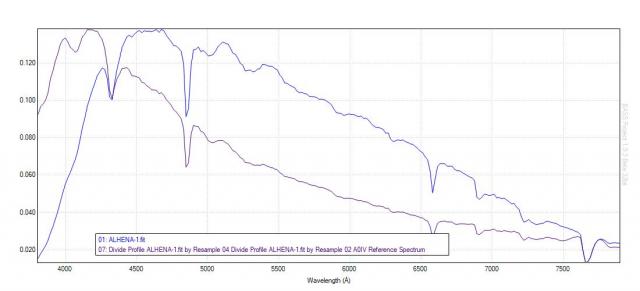 Hi Robin, Is this getting beter I followed you pfd as near as I can in BASS, Thanks for all your help, my treble is not very good with PC.
Hi Robin, Is this getting beter I followed you pfd as near as I can in BASS, Thanks for all your help, my treble is not very good with PC.peter
-
AuthorPosts
- You must be logged in to reply to this topic.
